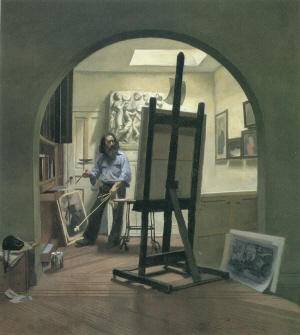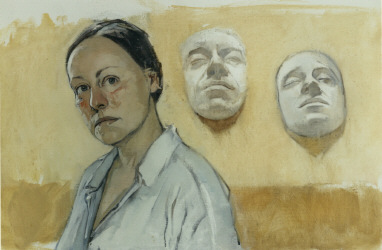 Two Enduring Influences and Friends:
Two Enduring Influences and Friends:
INFLUENCES
.
I'm
often asked: "Who are your influences," and "Who did you study
with?"
The following is an essay prepared for a show at the Lyme Academy College of Art
in Old Lyme Ct, highlighting the work of its faculty and the artists who
influenced them. The show took place in 2001--- With only minor revisions, the
following text is presented as it appeared hanging on the gallery wall next to
paintings by Mary Beth McKenzie and Harvey Dinnerstein.
 Two Enduring Influences and Friends:
Two Enduring Influences and Friends:
Harvey Dinnerstein and Mary Beth McKenzie
By Dan Gheno
I’ve known Harvey Dinnerstein and Mary Beth McKenzie for more than half of my life. I’ve known of their work for much longer.
I attended a figurative oriented art school called the Santa Barbara Art Institute in the early 70’s. I was lucky enough to study with many accomplished artists there and I learned a great deal about the construction of the figure, volume and form as well as formal issues from artists like Douglas Parshall, Priscilla Bender-Shore, Dick Phipps, Gerry Haggerty, James Armstrong and privately with Harry and Inge Norstrand.
Some of my favorite, local, “blue-chip” California artists like Richard Diebenkorn , Wayne Thiebaud, Howard Warshaw and Rico Lebrun were well esteemed within the State. But outside of the Art Institute, the South Coast art scene didn’t seem to offer much support or encouragement to any young artists who currently chose figuration as a fine-art goal.
Many of us therefore looked towards a group of New York artists (who seemed to have acquired at least a grudging acceptance from the art establishment) for inspiration and validation of our course. These exemplars included artists from an older generation like Raphael and Moses Soyer, Alice Neel and John Koch; a younger group of artists including Harvey Dinnerstein, Burton Silverman, David Levine, Alfred Leslie, Aaron Shikler, Seymour Pearlstein and Lennart Anderson; and a very young generation of New York figurative artists including Charles Pfahl. Mary Beth McKenzie and Ron Sherr were also active members of this younger group, but I was not yet aware of them at the time.
As a youngster, even before I started to actively draw in the early sixties, I was particularly taken by the startling, memorable images of the Civil Rights movement which both Harvey Dinnerstein and Burt Silverman produced for various magazines. They demonstrated with their work that narrative, visual reportage and socially informed work was still a valid form of fine-art. While some of my 70’s contemporaries dogmatically viewed their work as “illustration,” I saw it as a continuation of that “grand,” difficult, tradition that Rubens, Caravaggio, Kollwitz and many other Old Masters pursued in their own revered work, and something to at least aspire to in my own work.
Much later when I moved to New York, I became aware of Mary Beth McKenzie’s work through reproduction and her first one-person show. Like Harvey’s work, her masterfully painted figures seethed with psychological power, and I was greatly impressed by the manner in which her compositions breathed with air and depth.
I moved to the East Coast to purposely seek out a stronger figurative community and spend time with the Old Masters at the Metropolitan Museum of Art. I was very surprised and excited to learn that Harvey Dinnerstein taught at the Art Students’ League ---- and later Mary Beth Mckenzie, Terance Coyle and Ron Sherr at the National Academy School in New York.
I studied with Harvey, Frank Mason, David Leffel, Gabriel Laderman, Robert Beverly Hale and Ted Seth Jacobs at the League in the late Seventies and with Harvey and Mary Beth at the National Academy School in the beginning Eighties. Their influence on my work is extensive, and I feel particularly honored to have had both Harvey and Mary Beth as my teachers as well as my enduring friends.
The above left painting is copyrighted by Harvey Dinnerstein. The above right painting is copyrighted by Mary Beth McKenzie. Text is copyrighted ©2001 by Dan Gheno
Click Here to Return to Home Page